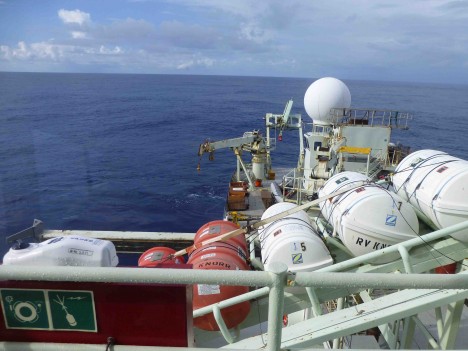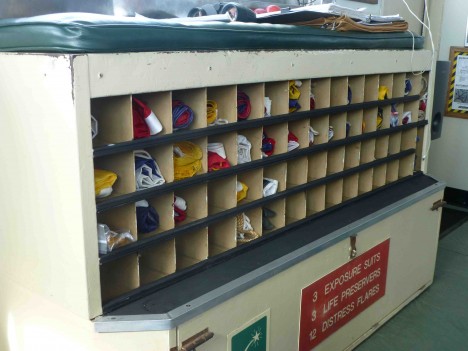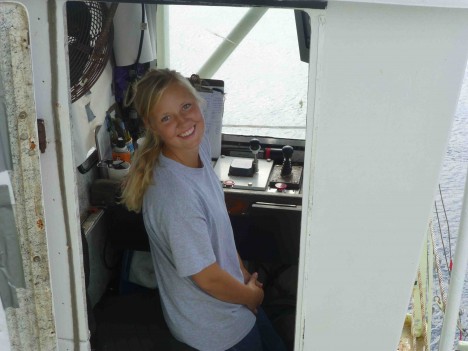By Eric Lindstrom
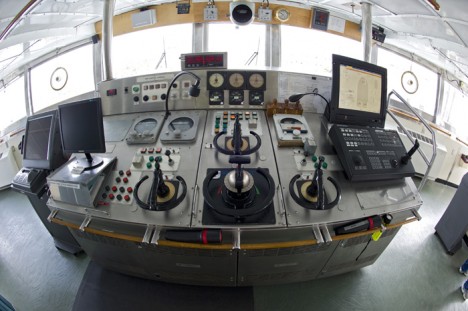
The bridge of the Research Vessel Knorr. (Photo by Tom Kleindinst, Woods Hole Oceanographic Institution.)
Almost everyone can imagine the bridge of a ship – from the movies, a tour of a ship, or maybe you are the master of your own vessel. It is the place where control of all ship operations is commanded. On the bridge of the Knorr, an officer and a seaman are always present and in full control of the vessel, for the safety of all aboard and effectiveness of the ship as a research platform. It’s amazing what they can do and the various skills that are required to command a research vessel.
The bridge and chart room house all the ways and means needed to safely navigate Knorr, maintain her stability, maneuver her on station, and to communicate with anyone as necessary. Like the dashboard of a (sophisticated) car, they have a display of key engineering functions and to operate the ship in both manual (i.e., you driving) and autopilot (car cruise control) modes.
One key function of the master that you may not know about is to complete calculations assessing the stability of the ship and to ballast her correctly as fuel is consumed or heavy scientific gear is deployed. Seawater ballast tanks are available to compensate for changing conditions (Knorr uses between 1,800 and 3,800 gallons of fuel per day).
There is an overarching sense of situational awareness that permeates life on the bridge of any research vessel. The captain and the mates are always alert of changing conditions like weather, location, time, ship traffic, and science plans. With the rhythm of the ship, they are also keenly attuned to watch changes, meals, rest periods, and fresh coffee brewing. Also, there is all the important watch for fish. The chief engineer must be informed 24/7 of any sighting. We all need our protein…
That leaves the oceanographers to focus on the science bits – like what the tiny variations of salinity are in the top 3,000 feet of the ocean! That’s sweet. The bridge looks after us, we look after the ocean, and everyone is, well… working. Not much else to do out here.
Knorr has amazing capability to stay on station. In gentle sea conditions, it’s quite possible to stay on location to within a few feet. The officer on watch can set the ship to keep position, so their attention can be shifted to observing deck operations further aft on the ship.
Captain Adam Seamans has been a Master of Knorr since 2008. He started with Whoods Hole Oceanographic Institution (WHOI) as an Able Seaman in 2000, where one of his first duties was to clean a science cabin after a head overflowed. My, how times have changed! Now he commands the 22-member crew of Knorr and navigates her to all corners of the globe. Maybe he still has to deal with a lot of crumby jobs, but they are mostly of the cleaner variety!
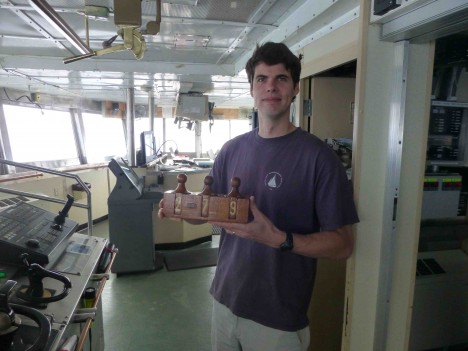
Captain Adam Seamans holding the Knorr’s heading box, which contains three wooden blocks with ten digits inscribed in each. One can set the heading of the ship 0-360 degrees and place this in front of the seaman steering the ship’s course. For the photo, the heading is set at 279 – the length of Knorr in feet.
The Knorr has enormous capability for communication – via satellite phone or internet or radio. In close quarters with foreign vessels, Knorr can communicate the old-fashioned way via flags. Sequences of brightly colored flags have universal meanings to mariners.
Finally, I thought I would call your attention to training. All the officers aboard Knorr have great experience and through my decades of oceanography, I have found maritime officers always passing their knowledge and experience forward to others. Teaching and sharing, honestly, what a great concept! It makes for safer seas.
On this voyage we have a learner, a cadet named Anna, from Sweden. She is just 18 and approached a WHOI captain about being a cadet aboard one of their vessels. Sometimes you need to be careful what you wish for! Anna has been working all the jobs on the ship for our expedition. Just today, she was driving a winch by herself for the first time, looking happy and proud! Her initiative and hard-working nature are an example for all of us. Sometimes the teachers become the students… Anna, Bravo Zulu!





